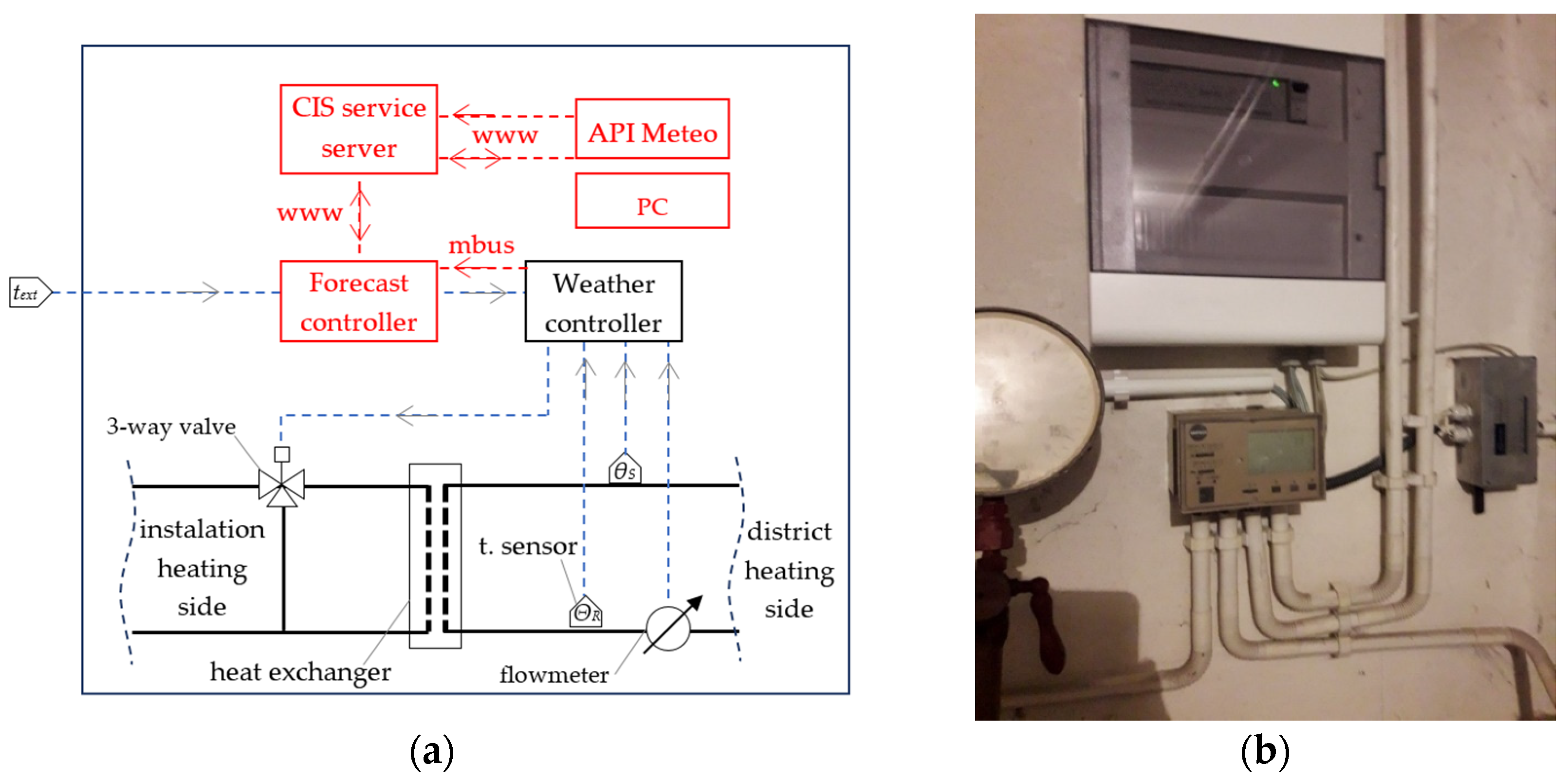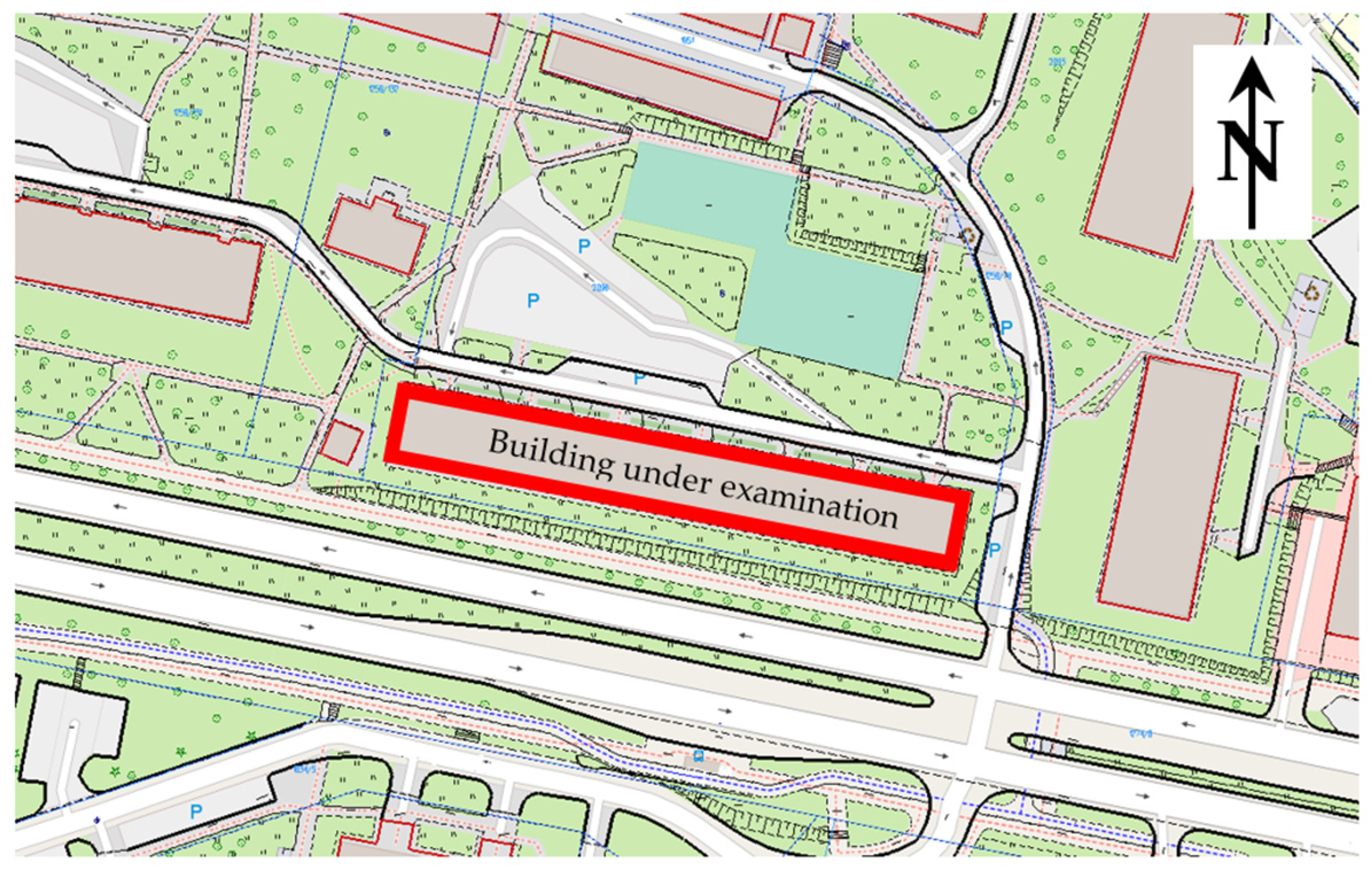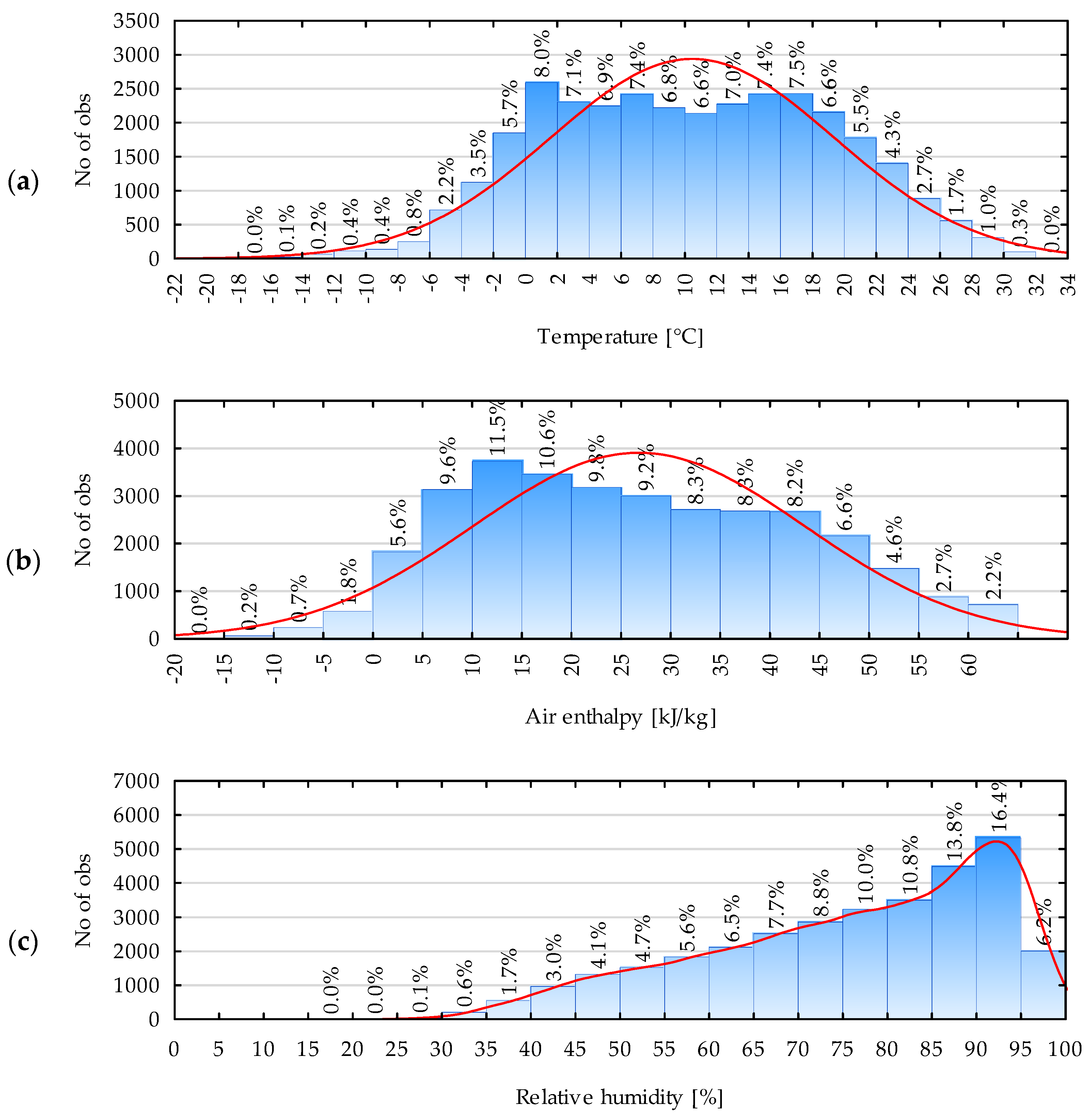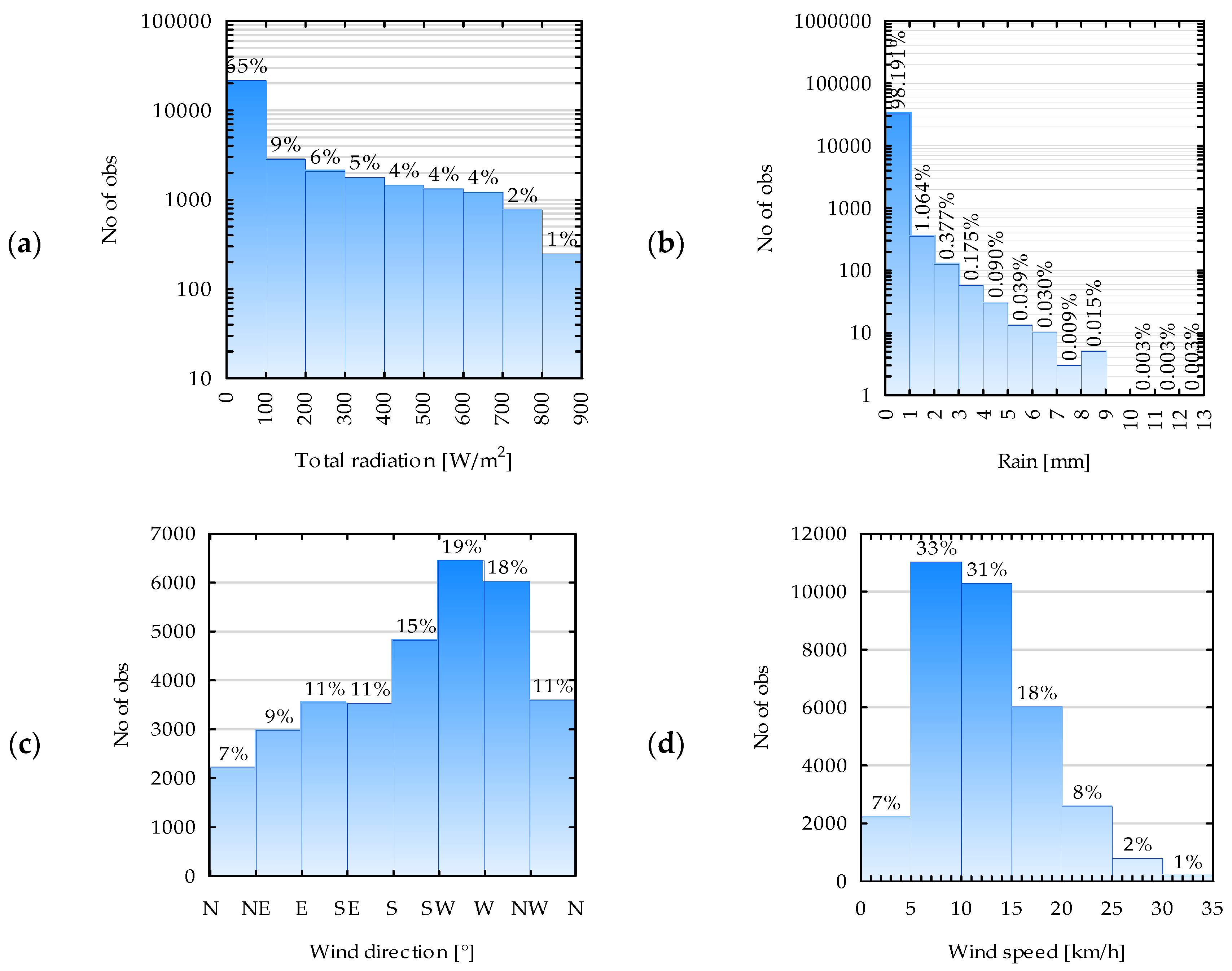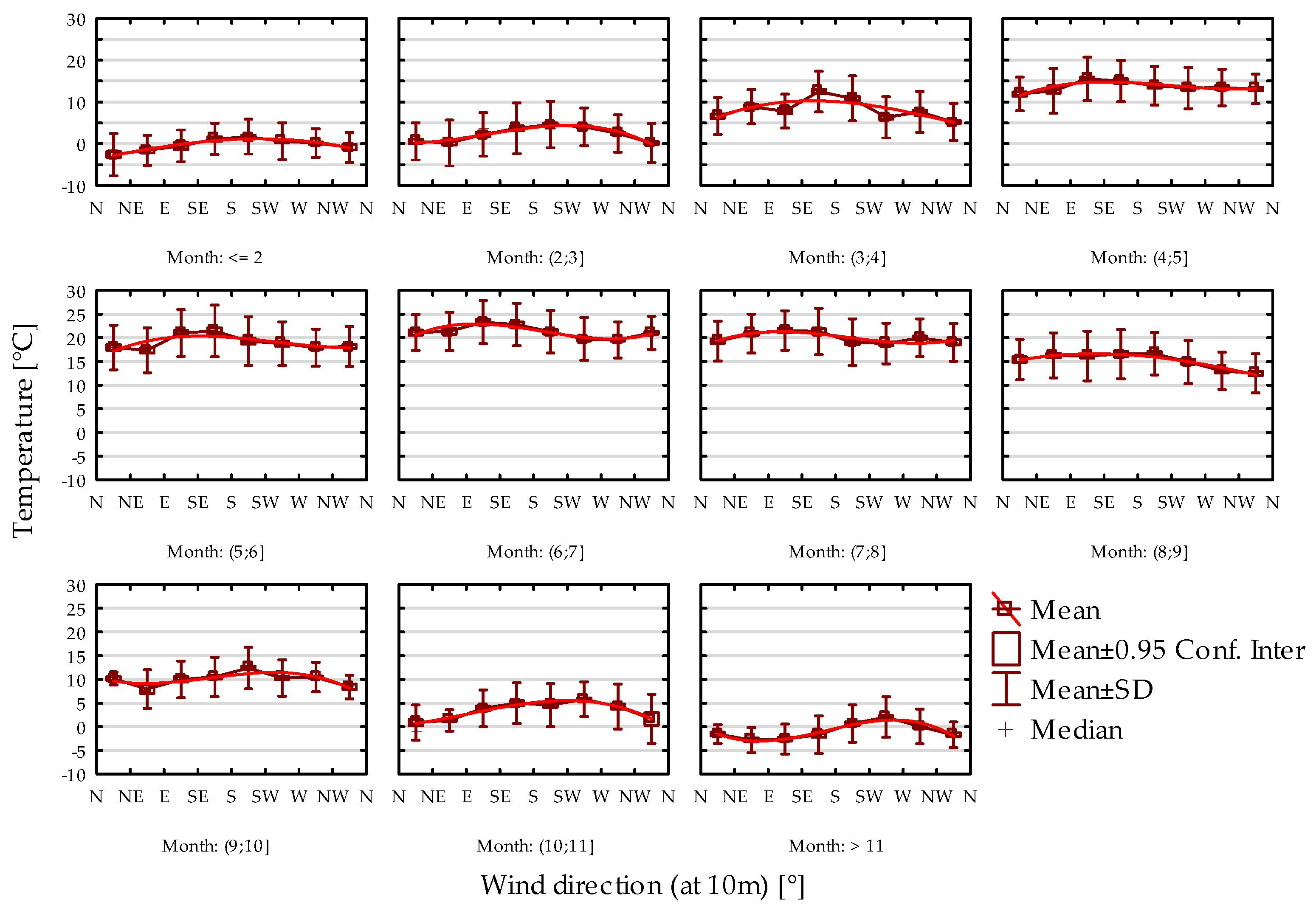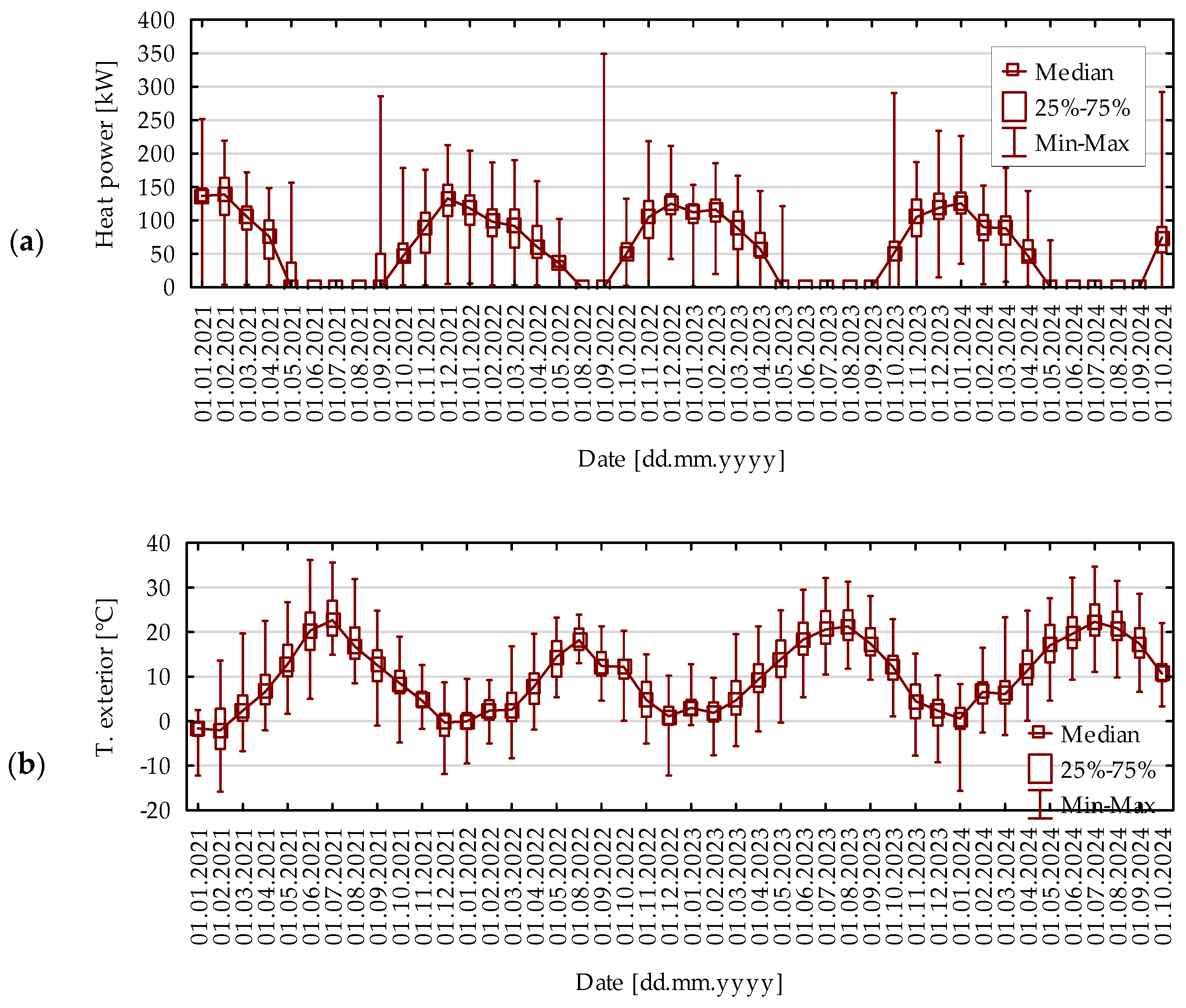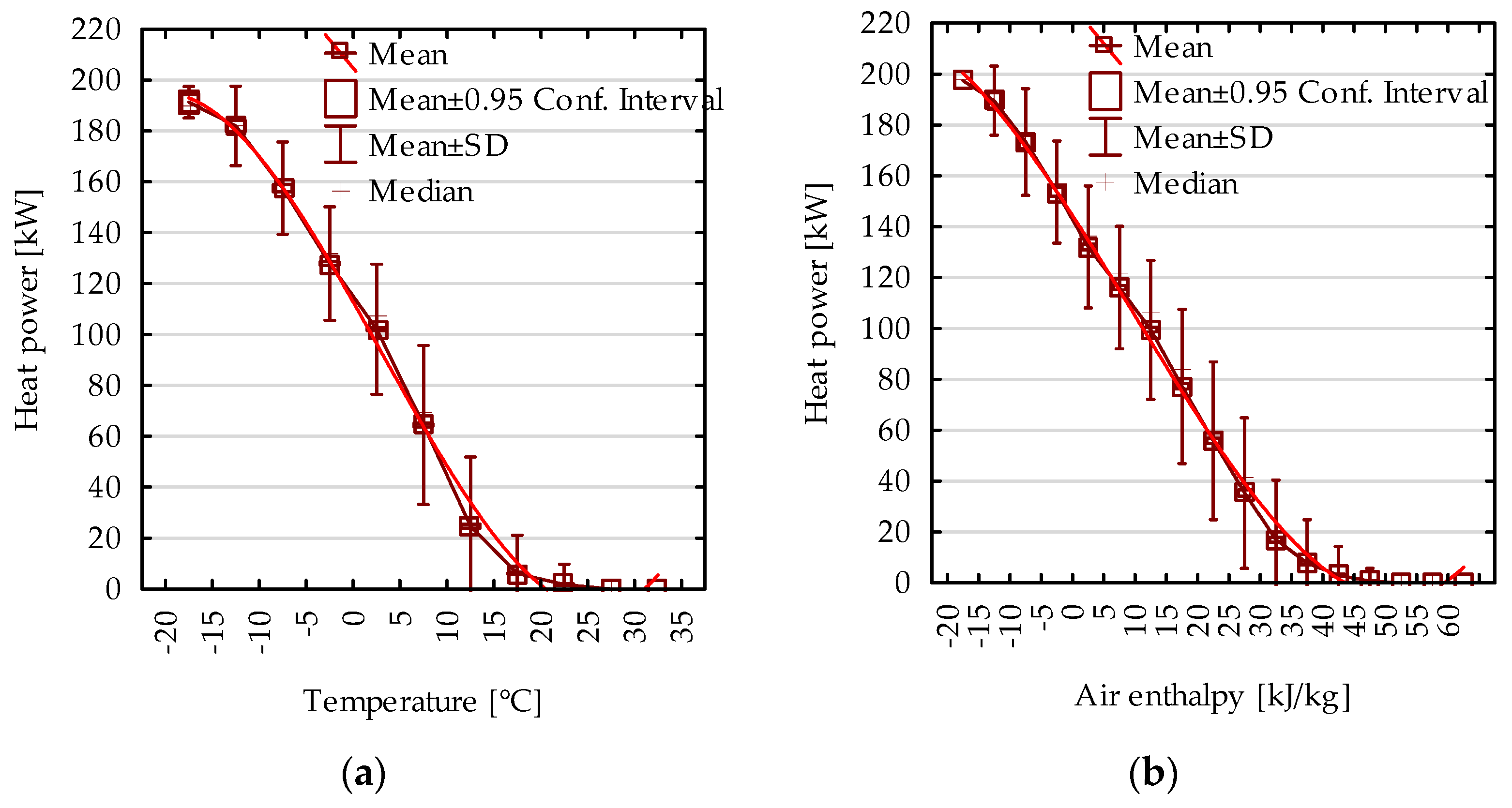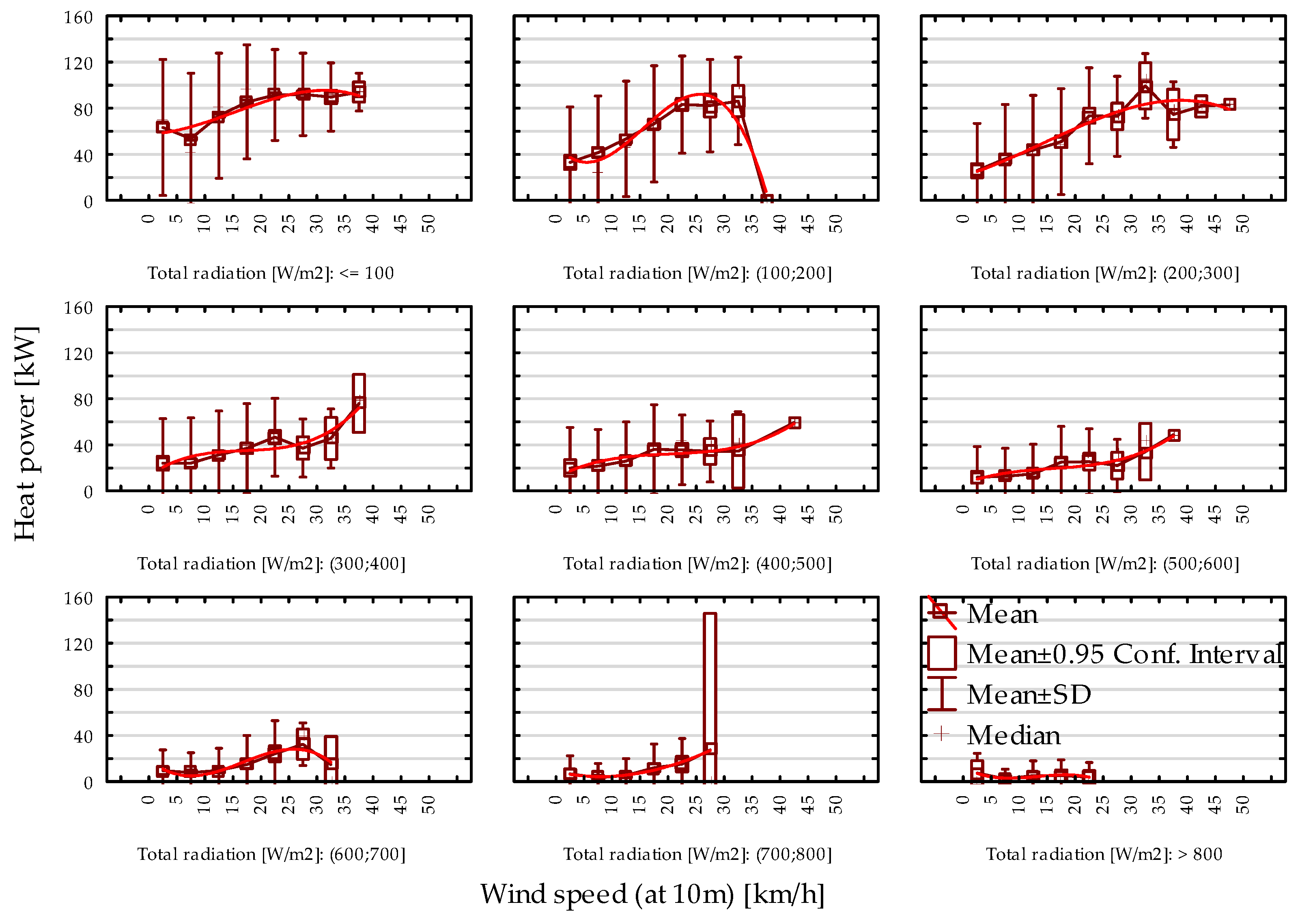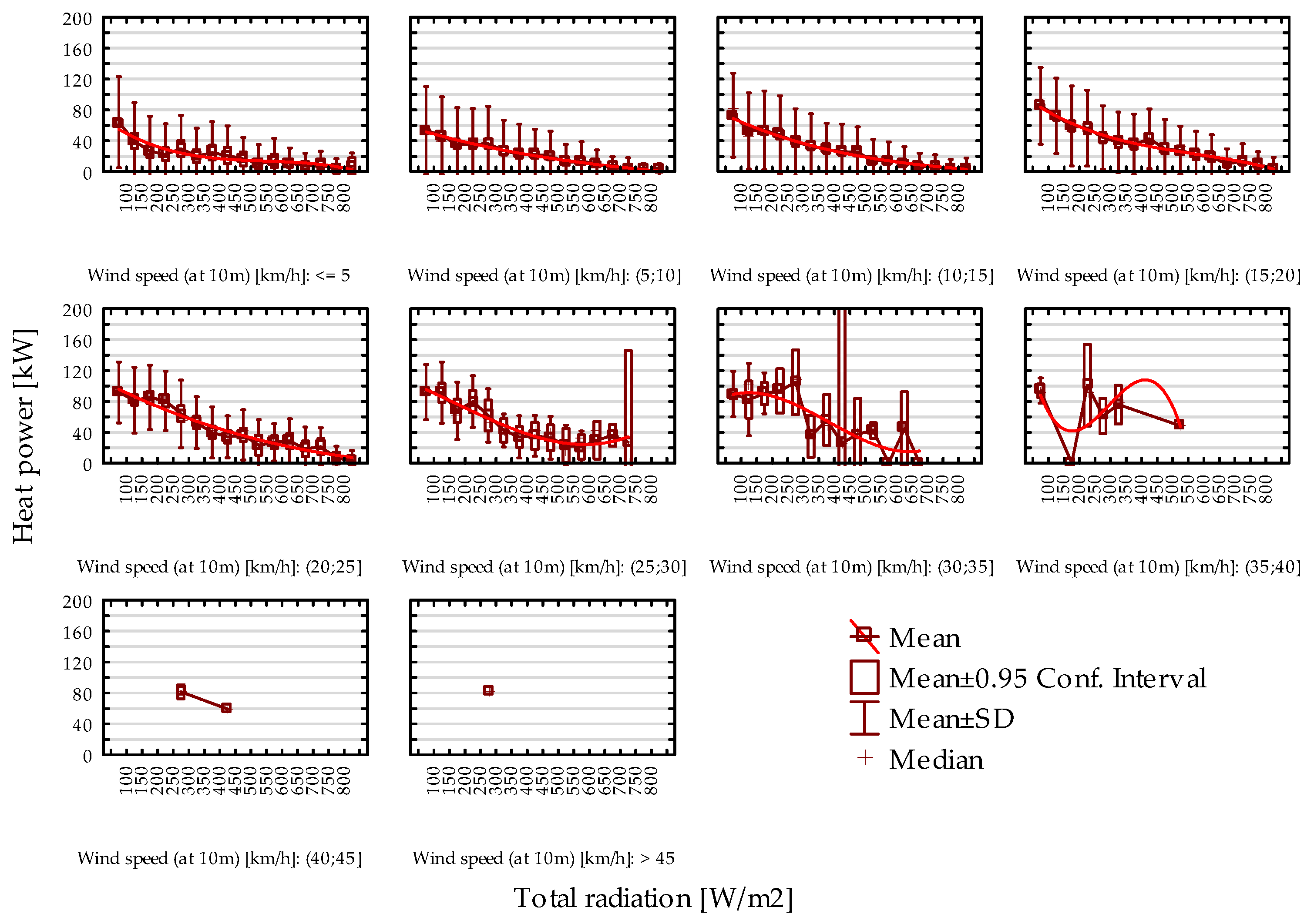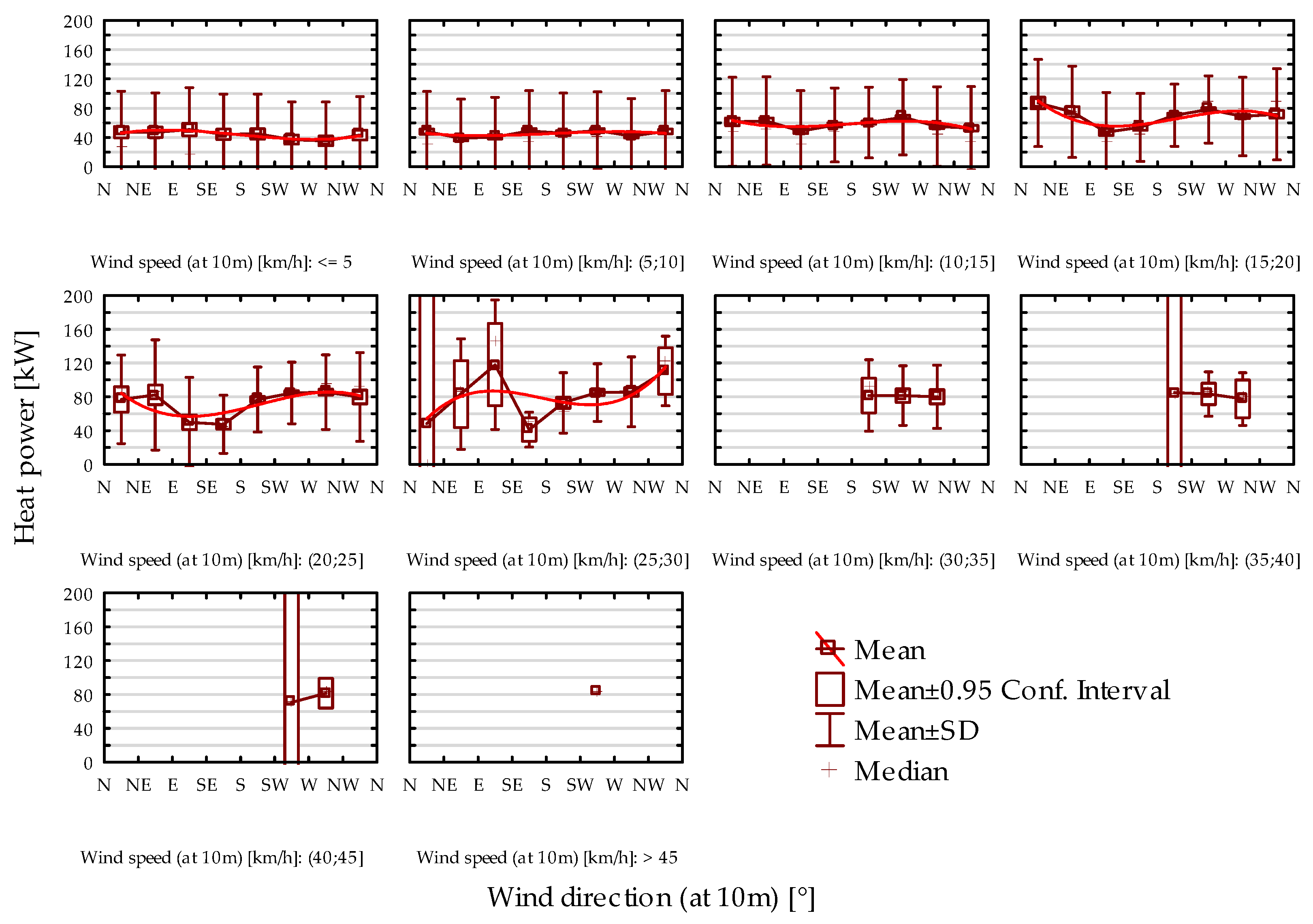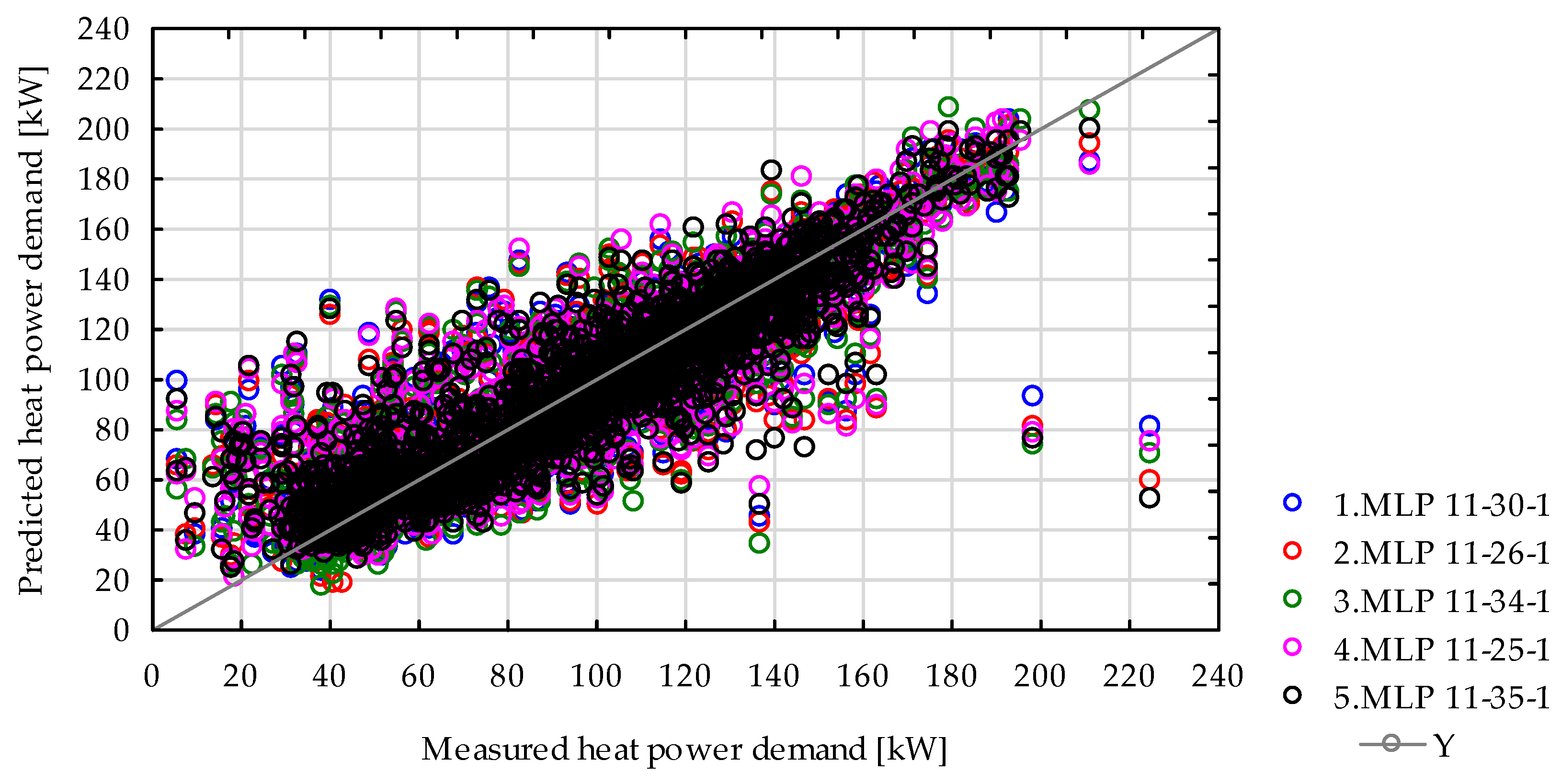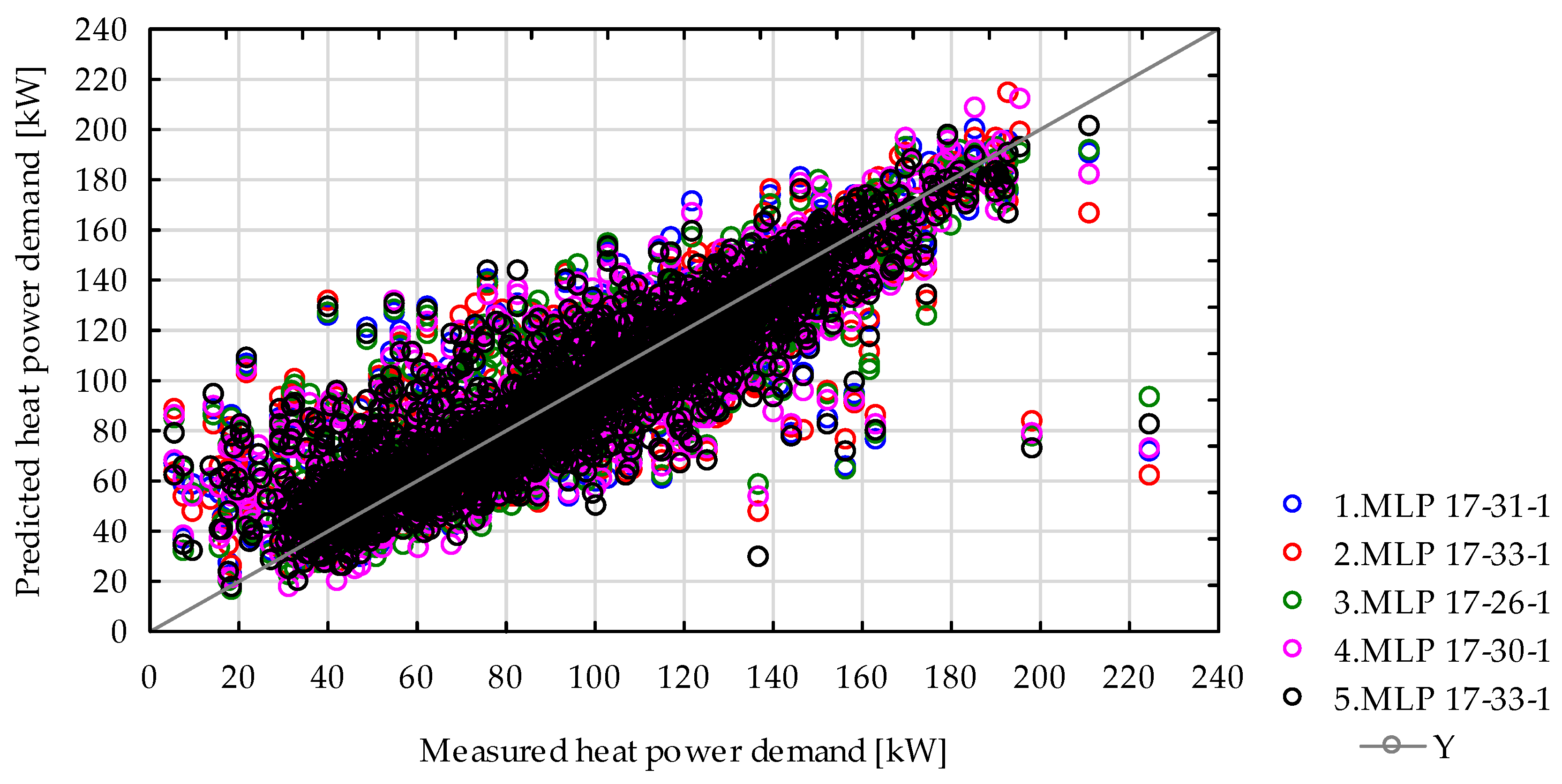2. Advanced Method of Energy Consumption Assessment in Buildings
Aligning building energy requirements with the principles of sustainable urban development (SUD) necessitates the adoption of appropriate technologies by users, managers, and designers. Reducing carbon emissions while optimizing household energy consumption in residential buildings has emerged as a global imperative.
The application of energy demand management, particularly in retrofitted buildings, involves a complex interplay of socio-economic and technical factors. Within the framework of Demand-Side Management (DSM), these measures aim to achieve tangible energy savings, thereby improving living conditions while supporting SUD objectives [
9].
A gradual and systematic approach to implementing energy optimization is a policy goal for many countries. For example, in China, long-term economic planning and legislative provisions focus on introducing new technologies, monitoring implementation, and achieving measurable energy savings [
10].
However, optimizing energy use in buildings is not solely about improving economic efficiency. Equally significant is the need to manage energy flow, enhance data integration, and enable sustainable forecasting. These efforts support intelligent, controlled energy consumption tailored to various building types. Studies evaluating building energy consumption often emphasize savings achieved through energy distribution and management processes. This issue is particularly relevant in countries with shorter heating seasons, such as those in Southern Europe, where energy use aligns with scheduled delivery periods. These actions have demonstrated significant reductions in primary energy consumption—66%, 74%, and 65% in continuously heated residential buildings in Greece, Portugal, and Spain, respectively [
11].
The non-energy benefits of retrofitting are frequently overlooked. Beyond reducing carbon footprints, retrofits can lower the atmospheric emissions of greenhouse gases, such as SOx, NOx, and benzopyrene. Complex retrofitting processes, often referred to as deep thermo-modernization, have shown variable success in improving energy and environmental performance. For instance, results indicate that deep retrofitting benefits educational buildings not in all conditions. Without financial subsidies, the complexity and cost of these processes may render them unfeasible [
12].
The global trend of constructing energy-efficient buildings necessitates constant comparison with reference buildings of similar types to evaluate the achieved energy outcomes. Combining home control systems with energy-saving measures can enhance energy efficiency by reducing demand and improving monitoring and management processes—especially in smart technologies [
13,
14].
The search for the relationship between the economic efficiency of the thermo-modernization solutions used in relation to the energy effects achieved has become the primary determinant of the implementation of appropriate technical solutions. In many cases, it is easier to apply costly technologies with the use of renewable energy sources in public utility buildings, such as educational, administrative, or health care facilities, due to the participation and involvement of public and private capital in the processes [
15].
The growing demand for energy efficiency in buildings has led to the development of advanced artificial intelligence (AI) techniques for predicting heat power demand, especially in heating, ventilation, and air conditioning (HVAC) systems. The adoption of advanced technologies, such as artificial neural networks (ANNs), has shifted from being a challenge to becoming a necessity. ANNs provide an alternative method for solving complex problems by learning from historical data rather than traditional programming techniques [
16].
It turns out that ongoing research [
17] in this area must distinguish between energy demand and energy consumption forecasting, which, given the vast amount of output data, should be conducted using ANNs. Therefore, it was crucial to examine how ANNs were implemented and on which models. Additionally, the results achieved with these models and the emerging trends were assessed. Understanding these principles aimed to eliminate the increasingly common phenomena of repetitive applications and methods used in developing action models to optimize the performance of machine learning (ML) techniques.
Predictive systems use data on atmospheric conditions (e.g., outdoor temperature, insolation, and wind speed), building characteristics, and occupancy patterns. On this basis, it is possible to forecast variable thermal energy demand. For example, during periods of intense sunshine, the control system can reduce heating to take advantage of natural heat gains, while during periods of high winds, it takes into account additional losses through ventilation or thermal bridges. The prediction of heat demand in thermally upgraded buildings is crucial to fully realize the potential of energy efficiency. By accurately predicting energy demand, it is possible to implement intelligent control systems that dynamically adjust heat supply to the actual needs of the building, minimizing energy losses.
The process of modeling and forecasting energy consumption in multi-family residential buildings still appears to be underdeveloped. Such research can yield reliable and simultaneously optimal solutions for creating energy consumption simulations. Computational models based on the Levenberg–Marquardt and OWO–Newton algorithms achieved noteworthy determination coefficients in the range of 0.87–0.91, which is a strong result and comparable to findings reported in other publications [
18].
The work and analyses aimed at finding appropriate methods and algorithms for forecasting energy consumption in residential buildings based on ANNs must be continuously corrected and improved. Energy consumption and the prediction of hourly load profiles enabled the evaluation of variable relevance as well as the determination of the number of free parameters required to construct the output model [
19]. The obtained results demonstrated that statistical analysis, as a significant component of neural models, can serve as a valuable tool for developing simple and, most importantly, highly efficient neural models specifically applicable in the field of building energy management.
One of the methods to optimize the results obtained is their multi-source extraction and comparison. Another study [
20] used three new methods of intelligent grasshopper optimization algorithm (GOA), wind-driven optimization (WDO), and biogeography-based optimization (BBO), which influenced the optimized prediction of heating loads and cooling loads of buildings.
The necessary factors to consider in forecasting energy consumption (including electricity) took into account demand and ambient temperature from the perspective of hourly or seasonal variation. This makes it difficult to match energy consumption during periods of long-term and short-term demand in the same time frame. Another study on office buildings was to compare the forecasting results obtained by the traditional method and the ANN method [
21]. The proposed approach divides energy demand data into fixed time periods that include operating hours to reduce the impact of human activity. Once a suitable weather variable is found to match the energy demand during working hours, the building’s energy constant can be predicted here. The second proposed approach uses an ANN to match hourly load, peak load, and occupancy rate with multiple variables. In this approach, data for energy demand is divided into shorter time ranges, hours with no occupancy, hours of full occupancy, and fuzzy hours in between, where occupancy rates vary with time and weather variables. The proposed approaches are validated by case study data. Simulation results show, comparing the traditional method with the ANN method, that both proposed approaches have less root-mean-square error (RMSE) in predicting building electricity demand.
In another article [
22], researchers compare the prediction capabilities of five different intelligent system techniques for predicting electricity consumption in administrative buildings in the UK. These five techniques are multiple regression (MR), genetic programming (GP), artificial neural network (ANN), deep neural network (DNN), and support vector machine (SVM). The models are developed based on five years of observed data of five different output parameters, such as solar radiation, temperature, wind speed, humidity, and weekday index. The weekday index is an important parameter for distinguishing between working days and days off. The results show that ANN performs better than all the other four techniques with a percentage error (MAPE) of 6%, while MR, GP, SVM, and DNN have 8.5%, 8.7%, 9%, and 11%, respectively. The authors also emphasize that this type of research can also cover other categories of buildings and will help optimize energy consumption forecasting for different types of buildings in the future.
A recent study from 2024 using ANNs is the reverse of the previous post [
23]. All scholars have used a bottom-up model, i.e., extensive simulations and calculations of energy consumption of buildings, but here we are dealing with a model for predicting hourly heat demand at the national level. This approach significantly reduces the time and complexity of the prediction by reducing the number of model input types through feature selection (making the model more realistic). Such a model can be adapted using less meteorological data, while accurately predicting hourly heat demand throughout the year. The model provides a framework for obtaining accurate heat demand forecasts for large-scale areas, which in turn can be used as a reference for making appropriate decisions.
Another study [
24] in this area addresses the issues of using ANN to predict the heat demand associated with air conditioning in non-residential buildings. The reliable preliminary prediction of the thermal energy demand of a building is performed with the help of detailed dynamic simulation software, which also requires knowledge of the heat balance and several output data. The authors’ research goal was to identify the best ANN topology, developing a tool for determining both fast and simple thermal energy demand of a non-residential building with only 12 well-known thermophysical parameters without using thermal balance data. The authors describe how to train a network to develop an accurate thermal energy database to form the basis of specific ANNs. Another approach to the study involves considering an ensemble of neural networks [
25]. Various ANNs are used to predict thermal energy consumption on a university campus: forward neural network (FFNN), radial basis function network (RBFN), and adaptive neuro-fuzzy interference system (ANFIS). For each type of neural network, three models are analyzed (using different initial parameters). In order to achieve accuracy in predicting energy consumption, not just individual networks but the entire ensemble of neural networks is studied. Three different combinations of results are then analyzed. The study shows that all the proposed neural networks can predict heat consumption with high accuracy. Using the whole ensemble of networks gives even more precise results. ANN, due to their capacity for capturing complex, nonlinear relationships between various factors like weather conditions and occupancy rates, have shown substantial promise in reducing prediction errors [
26]. Moreover, multi-objective optimization methods, such as those employing the Artificial Bee Colony (ABC) algorithm, effectively balance energy efficiency with indoor thermal comfort [
27].
Research also emphasizes the application of artificial intelligence in district heating systems, where machine learning models and ensemble techniques improve the accuracy of heat demand forecasts [
28,
29]. Unsupervised learning algorithms, such as K-means clustering, have been applied to enhance the performance of HVAC systems by creating zone-specific heating management strategies [
30]. Additionally, advanced pre-processing techniques like wavelet transforms, coupled with tree-based ensemble models, further improve forecasting accuracy by accounting for temporal variability in heating loads [
31]. Collectively, these AI-driven approaches contribute to enhanced energy management, lower operational costs, and better thermal comfort in buildings.
In this study, we classified ANN into two distinct groups: those incorporating temperature forecasts several hours ahead and those operating without temperature forecasts. This methodological division represents a novel contribution to the field, addressing a significant gap in the existing research. Few scientific studies have conducted such comparative analyses in the context of predicting heat demand for buildings, particularly after thermal retrofitting—a critical area of investigation as retrofitting significantly alters thermal dynamics. By comparing these two network types, we aim to elucidate the role of outdoor temperature forecasts in enhancing model accuracy and robustness, offering deeper insights into their relative advantages and limitations. The integration of outdoor temperature forecasts accounts for future climatic variability, potentially improving demand prediction precision. Conversely, networks without forecasts represent a more generalized approach, applicable where forecast data are unavailable or unreliable. This comparison provides a comprehensive framework for optimizing ANN applications in real-world energy management scenarios, setting a precedent for future research.
3. Materials and Methods
3.1. General Description
Within the scope of this paper, the comparative results of the measured actual thermal energy demand for heating a multi-family residential building to the predicted thermal energy demand determined from general meteorological data are presented. Demand prediction was performed using ANN, and the following variables were used as input data: outdoor air temperature text (°C), outdoor air enthalpy hext (kJ/kg), wind speed ws (km/h), wind direction wd (°), wind gust wg (km/h), boundary layer height hbl (m), direct radiation idir (W/m2), diffuse radiation idif (W/m2), total radiation itot (W/m2), and general information like month and hour.
Air enthalpy is the total energy content of air, comprising both sensible heat (due to its temperature) and latent heat (due to moisture content or phase changes in water vapor). The air boundary layer height is the vertical distance from the surface to the level where turbulent fluxes of momentum, heat, or mass diminish significantly, typically marking the transition from surface-driven turbulence to free atmospheric conditions. Direct radiation refers to solar radiation that travels in a straight line from the sun to a surface without being scattered, diffuse radiation is solar radiation that has been scattered by atmospheric particles and arrives at a surface from multiple directions, and total radiation is the sum of both direct and diffuse radiation received by a surface.
In addition, neural networks were also determined for which additional variables related to the predicted weather from the weather service were taken into account predicted temperature (°C) from 1 to 6 h ahead:
t+1h,
t+2h,
t+3h,
t+4h,
t+5h,
t+6h. A flowchart illustrating the conducted analysis is shown in
Figure 1.
A correct estimation of the instantaneous heating energy demand allows for the optimal control of the heat or heat carrier supply. By taking all the meteorological factors into account, it is possible to make fuller use of heat gains or compensate for excessive heat losses. By knowing the dynamics of demand changes and the inertia of the heating system and the heated object, control can be intelligently implemented in advance.
In the beginning, the relationship between heating energy demand and individual climatic variables, including outdoor temperature, air enthalpy, total solar radiation, wind speed, and wind direction, was analyzed. Polynomial fitting functions were derived to model these dependencies. The statistical significance of the fitted models was evaluated using the ANOVA test, with results confirming significance at the 0.05 significance level. This analysis provides robust evidence of the influence of these climatic factors on energy demand, validating the relevance of the selected variables in energy modeling.
Subsequent analyses focused on predicting heating demand using ANN by incorporating a comprehensive set of climatic data. This approach aimed to leverage the full range of meteorological variables. By utilizing the available climate data, the ANN models were designed to capture complex interactions and nonlinear relationships between environmental factors and energy requirements, ensuring a more holistic and precise forecasting framework.
The prediction of energy demand for heating is, therefore, extremely important in terms of emulating the equivalent outdoor temperature. The heat demand can be determined according to the following formula:
where
—heat energy flux (kW),
H—building heat loss coefficient (W/K),
ti—design indoor temperature (°C), and
te—outdoor temperature (°C). Thus, from the transformation of the modified formula,
where
—predicted heat energy flux (kW) and
te,eq—equivalent outdoor temperature (°C), and the equivalent temperature can be determined as follows:
The equivalent outdoor temperature is emulated by the forecast controller for the weather control system.
It was decided to predict the heat demand since heat consumption is a directly measurable value. An approved heat meter that complies with the current technical requirements is used for the heat measurements. The predicted demand is very easy to compare to the current one. Another approach would be to directly determine the equivalent outdoor temperature based on climatic conditions, but verifying that value would be difficult.
In this research, the article does not present the results of the outdoor temperature text,eq emulation but instead focuses on estimating thermal energy consumption under the given conditions.
3.2. Measurement System
A typical control system for a heating system is weather control.
Figure 2a shows a schematic diagram of the heat exchanger in the building, connected to the district heating network (elements marked in black). The exchanger is designed for the heating system, without a hot water heating circuit. The controller measures the outdoor temperature
te and controls the supply temperature of the heating system through the three-way valve. From the measurement of the supply and return temperatures of the medium, as well as the mass flow, the consumed thermal energy (kW) is determined.
A modification in the system is a forecast controller connected via the Internet to the chief information system (CIS) server (polish acronym: NSI). This system is highlighted in red on the schema. The CIS additionally retrieves the current meteorological information from the API Meteo application for the geographic location specific to the installation site indicated in the settings. Then, the CIS determines the equivalent outdoor temperature. A data packet with the current external equivalent temperature settings for several hours ahead is sent hourly from the server to the forecast controller. The forecast controller emulates the outdoor temperature to the weather controller by adjusting the resistance value depending on the type of resistive outdoor temperature sensor. In addition, via the M-Bus interface, the forecast controller reads parameters from the weather controller that are related to thermal energy measurement and then sends them to the CIS. Measurements that were read by the forecast controller modules were outdoor temperature, supply temperature, return temperature, heating medium flow, delivered power, and heat consumption with an interval of every 10 min [
32,
33].
In weather mode, the forecast controller sends an unchanged temperature value to the weather controller, while in forecast mode, the equivalent temperature could be emulated depending on the estimated heat power demand Qpred. The system works ideally with weather controllers in heat exchangers connected to the municipal heat network.
3.3. Characteristics of the Studied Building with Their Heating Systems
The subject of the study (
Figure 3) was a multi-family building located in eastern Poland. The city is located in the III climatic zone, where the design temperature is −20 °C and the average outdoor temperature is +7.6 °C.
The object under study is a multi-family building built in the 1980s ÷ 1990s. The building is 5-story, with a basement, with a floor area of 5430 m2 and a volume of 14,661 m3. The building is in an area of multi-family housing, while there are numerous wooded areas between the buildings. The estimated number of residents in 75 apartments is 225 residents. The average design indoor temperature is +20 °C.
The building underwent thermal modernization. The external walls were insulated with expanded polystyrene (EPS) and finished with a mineral plaster coating. The heating system is made in the traditional way as water heating, with convection heaters. Distribution pipes (bottom distribution) are installed in the basement, to which numerous risers are connected. Radiators connected to the risers are equipped with thermostatic valves. The building is supplied with thermal energy from the high-parameter municipal district heating network through a heat exchanger room located on the ground floor of the building.
Additionally, windows in the stairwells and the main entrance doors were replaced to improve energy efficiency. In residential units, windows were gradually replaced by unit owners during periodic renovations as needed. Minor improvements were also made to the heating system, including replacing the outdated heat exchanger room with modern plate heat exchangers, equipping the risers with automatic balancing valves, and insulating the basement piping. The ventilation system remained unchanged and continued to operate as a natural (gravitational) system.
3.4. Data for ANN Analysis
Measurement data covers the range from 26 January 2021 to 13 October 2024. Readings were exported from CIS to a comma-separated data text file (*.csv).
The software tool utilized for the analysis was Statistica TIBCO Software Inc., version 14.0.0.15, employing the automatic ANN module. Within this framework, feed-forward regression neural networks were constructed. Each network consisted of a single hidden layer, containing between 25 and 35 neurons. The maximum number of hidden neurons was determined based on the formula 2n + 1, where n represents the number of input variables. This limitation on the number of hidden neurons was intentionally applied to mitigate the risk of overfitting, thereby enhancing the network’s generalization ability.
For activation functions, a diverse range was employed, including identity, logistic, hyperbolic tangent (tanh), and exponential functions, applied to both the hidden and output neurons. The networks were configured with input features corresponding to either 11 variables (without temperature predictions) or 17 variables (with temperature predictions). The specific inputs included outdoor temperature (°C), exterior air enthalpy (kJ/kg), wind speed (km/h), wind direction (°), wind gust (km/h), boundary layer height (m), direct solar radiation (W/m2), diffuse solar radiation (W/m2), total solar radiation (W/m2), temperatures forecast for future intervals (t+1h through t+6h), and other qualitative variables as with month and hour.
Each network generated a single output, representing the predicted heat demand. The dataset used comprised 18,184 valid records, which were randomly divided into training (70%), testing (15%), and validation (15%) subsets.
We used MLP (multi-layer perceptron) neural network in the format “MLP X-Y-Z”, where X represents the number of input nodes, Y the hidden neurons, and Z the output node. The networks without temperature forecasts have 11 input nodes, reflecting the basic meteorological parameters, while those with temperature forecasts include 17 input nodes to account for the additional predictive temperature data. The networks utilize the BFGS (Broyden–Fletcher–Goldfarb–Shanno) training algorithm, a popular choice for optimization in neural networks due to its efficiency in handling nonlinear problems. The error function SOS (sum of squares) is uniformly applied across all the models, ensuring consistency in optimization.
A total of 100 neural networks were trained, and from these, the five models demonstrating the highest validation accuracy were selected for further analysis. This rigorous approach ensured a robust evaluation and optimized the models’ predictive performance while preserving their generalizability to new data.
5. Discussion
Meteorological parameters, including outdoor temperature, wind speed, solar radiation, and air enthalpy, have an important role in determining the thermal energy requirements of buildings. Among these, outdoor temperature is commonly acknowledged as the dominant factor influencing heating demand [
35]. The data analyzed in this research corroborates this finding, showing a strong correlation between outdoor temperature fluctuations and heating energy consumption, especially within the range of −10 °C to 10 °C.
Wind speed and direction also significantly influence heat demand by affecting convective heat losses from building surfaces. The findings presented align with prior studies [
38], which emphasize wind’s role in increasing energy loss, particularly under low-insolation conditions. Solar radiation, on the other hand, introduces a compensatory mechanism by providing passive heat gains that reduce the need for heating.
This finding is consistent with studies in urban contexts, such as Kittaka and Miyazaki, who reported that wind direction significantly influenced temperature distributions across different zones in Osaka [
46]. Similarly, Lototzis et al. found a strong correlation between hourly wind directions and air temperature in Mediterranean climates, though their results suggest this relationship may diminish at broader time scales [
47].
The impact of wind direction on temperature in this study further emphasizes the importance of understanding localized wind flow dynamics. Mizukoshi highlighted the role of advection in altering temperature distribution patterns in urban areas, which is also relevant to the regional conditions examined here [
48]. The presence of obstacles such as buildings and forests, as noted in the study, can create localized variations in wind speed and direction, further modulating temperature. This is consistent with the findings by Hong-wei, who described complex interactions between wind direction and temperature over marine environments, suggesting that landforms and development may have an impact on meteorological parameters [
49].
Furthermore, the study’s temperature fitting functions for each month provide valuable predictive insights, offering a means to model the effects of wind direction on temperature. These models can be utilized to optimize heating systems, allowing energy providers to respond dynamically to forecasted temperature variations. The application of artificial intelligence algorithms could enhance the accuracy of these predictions by identifying subtle, location-specific relationships that may not be plain.
ANNs have emerged as a powerful tool for predicting heat power demand due to their ability to model complex, nonlinear relationships inherent in meteorological and energy consumption data. In this study, multiple ANN architectures were tested, including configurations with and without predictive temperature data.
Despite the quite simple architecture of ANN, the accuracy is comparable to other research that utilizes a hybrid or ensemble analysis. Hybrid approaches presented by Dasi et al. show that integrated machine learning models with metaheuristic algorithms, such as the Satin Bowerbird Optimizer combined with extreme gradient boosting, have shown high coefficients of determination (0.938048) for heating load predictions, indicating superior performance with minimal error values [
50].
A self-organizing map neural network was utilized by Dinmohammadi for feature dimensionality reduction, followed by an ensemble stacking classification model for energy consumption prediction. The stacking model achieved superior performance with an accuracy of 95.4% [
51].
This study by Gong et al. employed a feedforward neural network (FFNN) optimized using a multi-tracker optimization algorithm (MTOA) to predict the annual thermal energy demand and weighted average discomfort degree hours in residential buildings. The proposed model achieved excellent accuracy, with a Pearson correlation coefficient exceeding 0.96, outperforming traditional methods and similar algorithms in both training and testing phases [
52].
In research presented by Yamannage, a Neural Network Multi-Layer Perceptron (NN-MLP) achieved a high accuracy of 99.57% [
53]. But, the target variable in this study, the heating load class, was not treated as a continuous variable like in our research, but was instead classified into three discrete categories: low, medium, and high. These findings underscore the effectiveness of machine learning algorithms, particularly ANNs, in accurately classifying heating load classes, contributing to improved energy efficiency in residential buildings.
The prediction of heat power demand using meteorological data and ANNs represents a significant advancement in energy forecasting. This research highlights the critical role of parameters such as temperature, wind speed, and solar radiation in determining thermal energy requirements, while also underscoring the potential of ANNs to model complex, nonlinear relationships. However, the findings also point to several areas where further refinement is needed, particularly in terms of feature selection, model regularization, and the integration of predictive data. By addressing these challenges, future studies can unlock the full potential of ANN-based forecasting systems, paving the way for more efficient and sustainable energy management practices.
ANN models are inherently specific to the datasets and conditions under which they are trained, limiting their applicability to the object or system of origin. Geographic and topographic variability introduces significant shifts in climatic conditions, such as temperature ranges, wind patterns, solar radiation intensity, and humidity levels, which influence energy dynamics. Furthermore, buildings exhibit unique thermal behaviors, governed by diverse heat loss/gain coefficients, material properties, insulation standards, and dynamic thermal response characteristics. These differences highlight the challenge of generalizing ANN models across varying contexts.
Future research should focus on identifying and standardizing critical climatic and building-specific factors that significantly influence thermal performance. By establishing universal indicators—such as normalized heat transfer coefficients or dimensionless performance metrics—it may be possible to develop generalized ANN frameworks. Such advancements could enable the cross-regional application of ANN models, improving scalability while maintaining predictive accuracy across diverse environmental and architectural frames.
Good results should also be obtained by taking into account internal factors that directly or indirectly affect the consumption of thermal energy, especially quantitative variables such as a representative internal temperature, or qualitative variables such as the characteristics of the residents (age and nature of the daily schedule).
6. Conclusions
The study analyzed four years of meteorological data to assess the impact of external factors on building thermal energy demand. Key variables included outdoor temperature, humidity, wind, and solar radiation.
The analysis of the relationships between energy consumption and energy demand for heating confirmed a strong influence of outdoor air temperature and enthalpy. These relationships are effectively described by third-degree polynomial functions, with determination coefficients (R2) of 0.7443 and 0.6711, respectively. Insolation in the range of 0–800 W/m2, within specified wind speed ranges, was also found to have a significant impact. Furthermore, average wind speeds in the range of 0–40 km/h, within defined insolation ranges, were identified as influential. However, wind direction was determined to be statistically insignificant.
Neural networks are suitable for predicting the heat demand of retrofitted buildings. The average fit coefficient (R2) for networks without temperature forecasts is 0.8967, while for networks utilizing forecast data, it marginally increases to 0.8968. In thermally retrofitted buildings, the relationships between heat demand and individual meteorological factors are less distinct, with reduced wind impact due to improved building airtightness. Reduced solar radiation transmittance through windows decreases the risk of interior overheating in summer, lowering cooling demands, but on the other hand may also limit passive heat gains in winter, potentially increasing heating costs in some cases.
The sensitivity analysis highlights exterior temperature and solar radiation as critical inputs for ANNs in energy demand forecasting. For networks using temperature forecasts, the month index, current outdoor temperature, and 1–4 h forecasts are the most influential variables, with enthalpy also being significant. Direct and total radiation have slightly lower influences. For networks without forecasts, direct and total radiation dominate, followed by the current outdoor temperature and diffuse radiation, indicating varying input relevance based on forecast availability.

